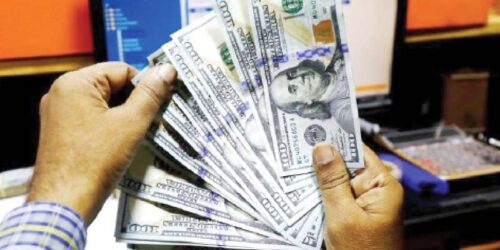A steep fall in the value of Pakistani rupee against foreign currencies since July 2018 caused an addition of Rs2.9 trillion or one-fifth to the public debt during the past three years, the Ministry of Finance said on Thursday.
The official reaction to media reports on the record surge in public debt, based on State Bank of Pakistan’s debt bulletin, came the day the rupee closed at nearly the lowest level in a year – Rs167 to a dollar. During intra-day trading, the Pakistani currency at one point touched Rs168.
“Exchange rate depreciation added around Rs2.9 trillion (20% increase) in public debt and this increase was not due to borrowing but due to re-valuation of external debt in terms of rupees after currency devaluation,” said the Ministry of Finance.
The Rs2.9-trillion addition to the public debt seems to have been worked out on the basis of a parity of Rs157.3 to a dollar, which was the closing rate at the end of fiscal year 2020-21. This showed a depreciation of Rs36 or 29.4%.
However, since June the rupee has further shed its value by nearly Rs10 to a dollar and its impact has not yet been included in the public debt.
The Pakistan Tehreek-e-Insaf (PTI) government once again blamed the Pakistan Muslim League-Nawaz (PML-N) for the steep currency devaluation, although many independent experts had then questioned the magnitude of the devaluation.
The finance ministry said that the exchange value of the rupee was maintained at an artificially high level in the past, which triggered the balance of payments crisis.
The transition to a market-based exchange rate regime, being an unavoidable policy choice, resulted in a sharp exchange rate depreciation leading to high inflation, high interest rates, slower GDP growth and lower import-related tax revenues, it added.
Despite the massive currency devaluation, neither the exports increased proportionately nor the imports could be curbed that again touched an alarming peak of $6.4 billion in August.
According to the State Bank of Pakistan (SBP) annual debt bulletin, the public debt increased to Rs39.9 trillion by June this year, an addition of Rs14.9 trillion within three years of the PTI rule. The total public debt increased by a whopping 60% from July 2018 to June 2021, an unsustainable 20% increase on average each year.
The addition of Rs14.907 trillion to the public debt in just three years was equal to 82% of the gross public debt that the last two elected governments of Pakistan Peoples Party (2008-2013) and PML-N (2013-2018) had added in 10 years.
The PTI government added on average Rs13.6 billion a day to the public debt, which was more than double the daily average addition of Rs5.8 billion by the PML-N government.
The finance ministry stated that since “most of the major adjustments to fiscal and monetary policies have been made, debt burden is projected to decline firmly over the next few years”.
The ministry said that in order to fully understand the underlying economic realities, there is a need to analyse the sources of increase in total public debt during the last three years.
During the past three years, the “government paid Rs7.5 trillion against interest servicing which explained 50% the increase in total public debt”, said the finance ministry. Preference towards short-term domestic borrowing in absence of adequate cash buffers resulted in short-term profile of domestic debt at the end of fiscal year 2018, it added.
This short-term profile led to high interest cost on debt as interest rates had to be increased significantly to curb rising inflationary pressures, said the ministry.
However, independent economists and high ranking government officials including Finance Minister Shaukat Tarin had questioned the central bank rationale to set the interest rate at 13.25% when the core inflation was in the range of around 7%. This massively jacked up the cost of annual debt servicing from Rs1.5 trillion at the end of the PML-N government to Rs2.7 trillion.
The central bank agreed to reduce the interest rate only after facing pressures from all sides but by that time significant damage had been done to the government’s fiscal position, said the sources.
Despite keeping the interest rate at 7% during the past over one year, the annual debt servicing cost still hovers around Rs2.9 trillion because of massive increase in public debt in the past three years.
The finance ministry said that the impact of economic slowdown due to the Covid-19 pandemic mainly resulted in higher than estimated primary deficits and Rs3.5 trillion (23% of the increase) was borrowed for financing of primary deficit.
However, it did not mention that the Federal Board of Revenue (FBR) collected Rs2.5 trillion less than its own targets sets for the last fiscal year. This gap was filled by taking new loans. The cumulative FBR target for fiscal year 2018-19 to 2020-21 was Rs15 trillion but the actual collection remained at Rs12.5 trillion.
The finance ministry said that due to factors like cash management and others Rs1 trillion (or 7% of the increase) was added with an aim to meet emergency requirements as well as due to difference between the face value (which is used for recording of debt) and the realised value (which is recorded as budgetary receipt) of government bonds issued during this period.
“The government took the revolutionary and economically sound step of not borrowing from the SBP and maintaining a cash buffer, which led to a one-off increase in deb,” said the finance ministry.
It said that a better way to measure level of debt is through debt-to-GDP ratio instead of looking at the absolute values of debt. In this light, it is important to highlight that Pakistan has witnessed one of the smallest increases in its debt-to-GDP ratio during pandemic.







